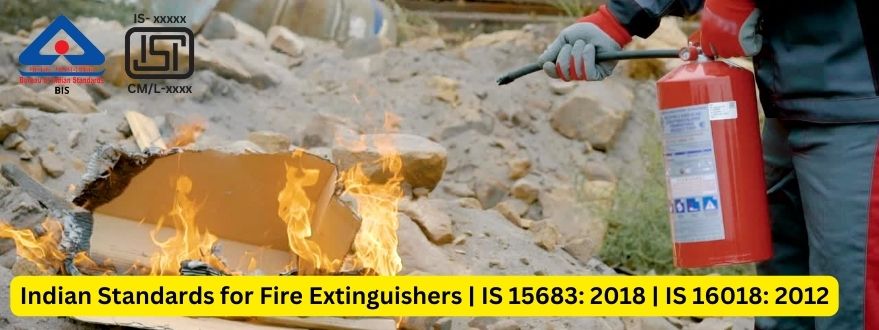
Indian standards for fire extinguishers set the benchmark for quality, performance, and reliability, ensuring that fire extinguishers are ready to protect lives and property in the event of a fire emergency.
Fire extinguishers are a vital tool in preventing and controlling fires, making them an essential component of fire safety measures.
In India, fire extinguishers are regulated and certified by stringent Indian Standards to ensure their effectiveness in safeguarding lives and property.
This blog will explore the importance of Indian Standards for both Portable fire extinguishers (IS 15683) and Wheeled fire extinguishers (IS 16018), focusing on their significance, scope, classification and the BIS certification process.
Indian Standards (IS 15683 and IS 16018) ensure the quality and reliability of fire extinguishers.
These standards have been assigned and are rigorously maintained by the Bureau of Indian Standards (BIS), a government body responsible for establishing and promoting quality and safety standards across various industries in India.
IS 15683 for portable fire extinguishers and IS 16018 for wheeled fire extinguishers are pivotal in safeguarding lives and property.
By complying with these standards, manufacturers can produce reliable and effective fire extinguishing equipment, while consumers can trust that the devices they purchase are capable of effectively combating fires.
Fire extinguishers combat fires in their initial stages, preventing them from escalating and causing severe damage. These essential tools are designed to tackle a range of fire hazards and have a profound impact on fire safety in numerous settings.
They are especially useful in homes, businesses, industrial settings, and public spaces where fires can occur due to various factors.
They play a pivotal role in addressing various classes of fires, including those involving solids, flammable liquids, electrical equipment, and specialized cooking fires, catering to a wide spectrum of fire risks.
There are two types of fire extinguishers, such as:
1. Portable Fire Extinguishers (IS 15683)
These are the most common types of fire extinguishers, designed for easy handling and mobility. They come in various sizes and are suitable for a wide range of fire types.
2. Wheeled Fire Extinguishers (IS 16018)
Wheeled fire extinguishers are larger and more powerful, designed for use in industrial and high-risk areas where larger fires may occur. They are equipped with larger capacities and longer hose lengths for effective fire control.
Understanding the categories of fires is crucial when selecting the appropriate fire extinguisher:
The Indian Standards IS 15683 and IS 16018 are vital in ensuring the effectiveness, reliability, and safety of fire extinguishers in India.
These standards are vital in assuring users that they have a reliable and effective tool at their disposal when fire emergencies arise.
Their role in the realm of fire safety is important for several reasons:
To ensure the safety of the public and property at large, the Department for Promotion of Industry and Internal Trade, Ministry of Commerce and Industry, Government of India, has issued a Quality Control Order (QCO) titled "The Fire Extinguishers (Quality Control) Order, 2023."
This order mandates that manufacturers of fire extinguishers must conform to the Indian Standards (IS 15683 and IS 16018) and bear the Standard Mark under a valid license from the BIS.
The Bureau of Indian Standards certification process encompasses several stages, from application to final approval.
Here's an overview of the general BIS certification process for fire extinguishers:
1. Application Submission
2. Document Review
3. Preliminary Plant Inspection
4. Sample Collection
5. Testing
6. Compliance Evaluation
7. Grant of License
Indian Standards for fire extinguishers, for both Portable fire extinguishers (IS 15683) and Wheeled fire extinguishers (IS 16018), are essential for safeguarding lives and property from the destructive power of fires.
At Brand Liaison, we navigate the BIS certification journey for manufacturers looking to get the certificate for their fire extinguishers or any other product.
Our expert team is specialized in providing comprehensive support and guidance throughout the BIS certification journey, ensuring that you will obtain the BIS certificate quickly and efficiently.